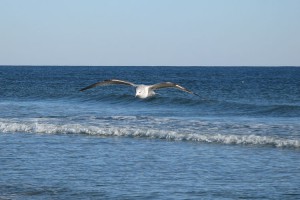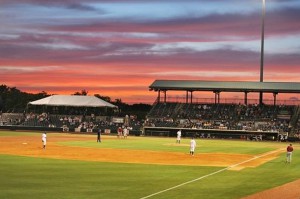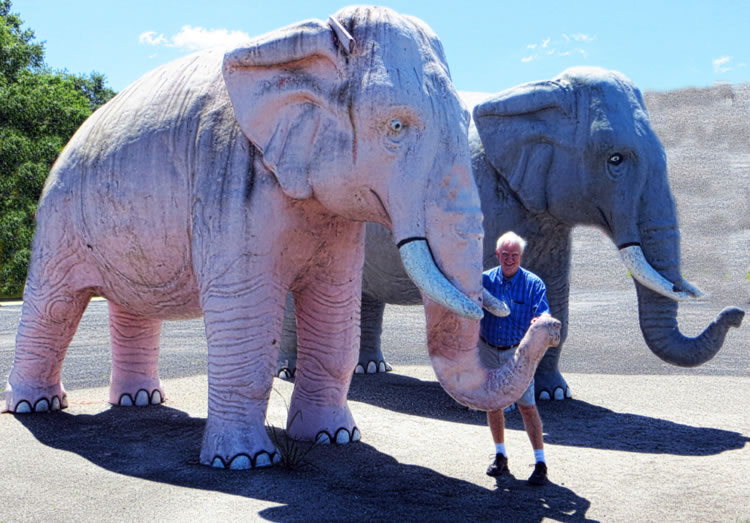MOONLIGHT AND MAGNOLIAS. It’s time for moonlight and magnolias — and sunlight and magnolias. Contributing photographer Michael Kaynard snapped this stunning picture of a magnolia bloom at Hampton Park over Memorial Day weekend. More: Kaynard Photography.
IN THIS EDITION | May 25, 2015 | Number 7.29PHOTO: Moonlight and magnolias
FOCUS: Folly Beach named one of nation’s best restored beaches
BRACK: Saturday wedding was refreshing, spiritual
IN THE SPOTLIGHT: Magnolia Plantation and Gardens
GOOD NEWS: Bark for your brew June 7, more
FEEDBACK: Send us your thoughts
CALENDAR: May 25+ — The start of summer
REVIEW: Did She Kill Him?
MYSTERY: Pink elephant
S.C. ENCYCLOPEDIA: The battles of Ninety Six
TODAY’S FOCUS
Folly Beach is one of nation’s best restored beaches
Staff reports | Folly Beach has one of America’s top five best restored beaches for 2015, according to the American Shore and Beach Preservation Association (ASBPA).
 “As Americans flock to our nation’s coastline during the upcoming beach season, most don’t even realize they may be enjoying a restored beach,” said ASBPA President Harry Simmons, who is mayor of Caswell Beach, N.C. “Coastal communities have restored more than 370 beaches in the United States, including such iconic beaches as Jones Beach in New York, Ocean City in Maryland, Virginia Beach, Miami Beach, South Padre Island in Texas, Venice Beach in California and Waikiki Beach.”
“As Americans flock to our nation’s coastline during the upcoming beach season, most don’t even realize they may be enjoying a restored beach,” said ASBPA President Harry Simmons, who is mayor of Caswell Beach, N.C. “Coastal communities have restored more than 370 beaches in the United States, including such iconic beaches as Jones Beach in New York, Ocean City in Maryland, Virginia Beach, Miami Beach, South Padre Island in Texas, Venice Beach in California and Waikiki Beach.”
Joining Folly Beach on the list are Santa Monica, Calif.; Galveston, Texas; Western Destin Beach, Fla.; and South Hutchinson Island/St. Lucie, Fla.
Folly Beach won the award, in part, for work to fix Folly Beach County Park, which became inaccessible in August 2011 after Hurricane Irene. Without the project to restore the beach, the park would still be closed, according to a press release.
In August 2011, after Hurricane Irene passed off the coast of South Carolina and rendered certain facilities at Folly Beach County Park inaccessible, the park was closed and public access and parking for over 400 cars on the west end of Folly Island was eliminated. This project restored the beach and allowed the reopening of one of Charleston’s most important public beaches. Without this project, the park would still be closed.
“As Charleston’s beach, the loss of the county park access was a loss to the whole community,” said Lee Weishar, chair of the Best Restored Beach Committee. “This project gave them back their recreational beach and had an added benefit of adding sea turtle and pelican habitat – making it a Best Restored Beach.”
The restored beach also provides an area that facilitates sea turtle nesting and shorebird habitat on the west end of Folly Island, the release said, adding, “Skimmer Flats, a major Eastern Brown Pelican rookery, is adjacent to the park site so restoring the beach was important to that population as well. The key element of the plan was construction of a terminal groin to retain sand; dune plantings were incorporated as well.”
According to the Charleston County Parks and Recreation Commission, permits were approved by the U.S. Army Corps of Engineers and the S.C. Department of Health and Environmental Control’s Ocean and Coastal Resource Management to allow the excavation of approximately 415,000 cubic yards of sand from a shoal in the Folly River. On May 5, 2013, stabilization began with pumping sand, and continued with the construction of a terminal groin at the southernmost end of property. The terminal groin is a 745-foot-long low-profile steel structure designed to trap and hold southerly flowing sand in place, while excess sand flows over and around the groin to rebuild the end of the spit. The project was funded entirely through a commission Capital Projects bond. The park reopened on July 3, 2013.
COMMENTARYSaturday wedding was refreshing, spiritual
By Andy Brack | Saturday was a nice day for a white wedding.
It was a Chamber of Commerce afternoon — clear blue skies, relatively low humidity, a breeze to keep gnats and mosquitoes away.
![]() Six dozen people crowded into white chairs next to blooming rose bushes. They sipped wine, strawberry-infused water and craft beer as the 5 o’clock hour approached. In the background, a fountain showered in a pond making the ambient sounds of a summer shower. Blue hydrangeas flanked the couple as a Lutheran priest intoned comforting Bible readings about love and gave a short sermon about the day-to-day joys and challenges of marriage.
Six dozen people crowded into white chairs next to blooming rose bushes. They sipped wine, strawberry-infused water and craft beer as the 5 o’clock hour approached. In the background, a fountain showered in a pond making the ambient sounds of a summer shower. Blue hydrangeas flanked the couple as a Lutheran priest intoned comforting Bible readings about love and gave a short sermon about the day-to-day joys and challenges of marriage.
It was a beautiful, refreshing service.
The bride wore a white designer dress as her octogenarian Southern mother looked on with a smile in the closest seat to the ceremony. The other bride wore a bright white shirt and off-white designer eyelet pants.
 Yes, it was our first gay wedding. It was reaffirming. Why? Not only did it make guests consider their own relationships, but Saturday’s wedding said volumes about our society. These two women, committed to each other for 15 years, never thought they would be able to get married in South Carolina. They didn’t want to run to another place to get hitched. They wanted to be married in their home state with their friends, just like everyone else. And Saturday, their dream came true.
Yes, it was our first gay wedding. It was reaffirming. Why? Not only did it make guests consider their own relationships, but Saturday’s wedding said volumes about our society. These two women, committed to each other for 15 years, never thought they would be able to get married in South Carolina. They didn’t want to run to another place to get hitched. They wanted to be married in their home state with their friends, just like everyone else. And Saturday, their dream came true.
Some question these unions on political or religious grounds. But, as we explained to our young daughters, committed relationships of any variety have one thing in common: love. And that love is what the bride and bride celebrated Saturday. So let’s keep things in perspective: Isn’t the crux of the teachings of spiritual masters and several religions to nurture loving relationships and spurn hate?
* * * * *
Now on to politics: In the most recent political column for Statehouse Report, we wondered why our own senior U.S. senator, Lindsey Graham, was running for president. The Upstate Republican has flirted with making an official announcement for weeks, saying he’s 99 percent sure he was going to do it. An announcement is expected within a week.
An Australian who follows politics wrote wondering whether Graham would get momentum if he won the state’s first-in-the-South GOP presidential primary next year. Yes, he would — but he’d have to win the primary, which at this point seems highly unlikely.
It’s hard to conceive of a path for Graham, who had six challengers last year in his Senate re-election bid. While he beat all in the primary with 56.4 percent of the vote, more than two in five voters were upset enough with him to vote for somebody else. That doesn’t show lots of strong support among the GOP base, some of whom were ticked off about Graham’s position on immigration and other issues close to the ultra-conservative wing of the party.
Fast forward to today. In national polls, Graham is averaging around 1 percent. An April Winthrop Poll indicates that only 7.6 percent of likely South Carolina GOP primary voters would support their home state senator in next year’s presidential primary. And while 37 percent said they would consider voting for him, 55 percent said they would not.
So just based on numbers, it’s hard to see how Graham could get the support at home to gain any momentum to win the GOP presidential nod. But why he would want to try at all? A number of theories emerge after talks with those who follow Republican politics: Maybe he wants another job (vice president, secretary of state or secretary of defense) if a Republican takes the White House. Or maybe he just wants to be a kingmaker to be able to anoint the next GOP presidential candidate and bring along key endorsements.
But a former Graham staffer says the senator would be in the race to win, not just pussyfoot around.
“He was not supposed to win the last primary without a runoff, but being a tenacious campaigner paid off,” said Bill Tuten, now a consultant in the Charleston area. “It’s another example of how he has been underestimated in the past and then over-performed. And in my opinion, he is going to join the race to win — that will be his only objective. I honestly don’t think that he would have an interest in a cabinet position.”
Andy Brack is editor and publisher of Charleston Currents and Statehouse Report, where a full version of his Graham column can be found here. He can be reached at: editor@charlestoncurrents.com.
IN THE SPOTLIGHTMagnolia Plantation and Gardens
 The public spiritedness of our underwriters allows us to bring Charleston Currents to you at no cost. Today we shine our spotlight on Magnolia Plantation and Gardens, founded in 1676 by the Drayton family. It has survived the centuries and witnessed the history of our nation unfold before it from the American Revolution through the Civil War and beyond. It is the oldest public tourist site in the Lowcountry and the oldest public gardens in America, opening its doors to visitors in 1870. Open 365 days a year, Magnolia offers its visitors splendid tours of nature and history and the role African-Americans played in the development of its award-winning Romantic-style gardens.
The public spiritedness of our underwriters allows us to bring Charleston Currents to you at no cost. Today we shine our spotlight on Magnolia Plantation and Gardens, founded in 1676 by the Drayton family. It has survived the centuries and witnessed the history of our nation unfold before it from the American Revolution through the Civil War and beyond. It is the oldest public tourist site in the Lowcountry and the oldest public gardens in America, opening its doors to visitors in 1870. Open 365 days a year, Magnolia offers its visitors splendid tours of nature and history and the role African-Americans played in the development of its award-winning Romantic-style gardens.
- Visit www.magnoliaplantation.com to learn how you can experience a complete plantation experience.
Bark for your brew June 7
You can enjoy a unique opportunity to sample some of the finest craft beers around at Bark for Your Brew, a dog-friendly, craft beer tasting. It’s set for June 7 at Joseph P. Riley, Jr. Park at 2 p.m. prior to the RiverDogs’ Dog Day Game scheduled against the Asheville Tourists (first pitch is 5:05 p.m.).
Bring your wing dog and sample fine beers from around the globe. An assortment of ales will be available to quench the taste buds of every craft beer enthusiast. The event will also feature dog-themed contests and activities including a howling contest, a mutt mingle, a tail wagging contest for the pet and their owner, an ice cream licking contest and a pre-game pooch parade. Chocolate Labrador Martinis and Poodle Coladas will be available for purchase.
Bark for Your Brew will benefit Canines for Service which is a national program that provides Veterans with disabilities a quality trained service dog. The program works with military prisoners at the Naval Consolidated Brig Charleston and teaches them how to train rescue dogs as service dogs for the wounded and injured Veteran.
Bark for Your Brew is a 21-and-over event. Tickets are $25 each and admission includes entry to the tasting, sampling tickets and a ticket for the RiverDogs last Dog Day baseball game of the 2015 season for you and your pet. The first 500 dogs through the gates will receive a special treat. Tickets are limited and may be purchased at the Riley Park Box Office or online at www.RileyParkEvents.com.
In other good news:
SCRA nominated. SCRA today recently that two company nominations were selected as finalists for the 2015 American Business Awards. This national award, known as The Stevie Award, recognizes the achievements and contributions of businesses worldwide. SCRA’s finalists are: the SC Launch Annual Report for the Best Annual Report Print and SCRA Executive Vice President Natalie Corrella for Woman of the Year, Non-Profit. SCRA has received numerous Stevies including the 2011 Stevie for Company of the Year, Non-Profit, and in 2012, SCRA CEO Bill Mahoney was recognized as CEO of the Year, Non-Profit.
Law school to stay open. The Charleston School of Law will accept an incoming class of first-year students in the fall, according to a statement by the school. The announcement was due to “continued and additional cost-cutting initiative and the dedicated support of members of the Charleston school community,” according to a statement. “The school’s landlords are cooperating with the school in efforts to consolidate facilities. Also the school’s year-long effort to reduce the size of the faculty and staff to a level consistent with the reduced enrollment will continue and begin to have a budgetary impact in September.”
Fashion Week has big year. Baker Motor Company Charleston Fashion Week® continues to grow and exceed expectations, according to a news release. With record attendance of more than 7,500 attendees, sponsor participation, and international media attention, the 2015 event made a significant impact to the local economy. According to the Dr. Wayne Smith at The College of Charleston, the 2015 5-day event boosted the local economy by close to $3.5 million in its ninth year, an increase of nearly 20 percent from 2014.
FEEDBACKSend us a letter
Rant. Rave. Tell us what you really think. If you have an opinion on something we’ve offered or on a subject related to the Lowcountry, please send your letters of 150 words or less to: editor@charlestoncurrents.com. Our feedback policy.
CALENDARThe start of summer
Dock Street lecture: 6 p.m., June 2, Main Library, 68 Calhoun St., Charleston. Just in time for Spoleto — you can learn all about the muddy origins of Charleston’s famous Dock Street at this free history presentation. More.
 Book sale: June 19 to 21, Main Library, 68 Calhoun St., Charleston. The Charleston Friends of the Library will present its second annual book sale of the year with great bargains, good books and a chance to support your library system. More info.
Book sale: June 19 to 21, Main Library, 68 Calhoun St., Charleston. The Charleston Friends of the Library will present its second annual book sale of the year with great bargains, good books and a chance to support your library system. More info.
Shaking a leg. The Folly Beach Pier is set to have more Moonlight Mixers throughout the summer starting at 7 p.m. A DJ will spin great old tunes to keep your feet moving. Other dates are June 19, July 24, Aug. 21 and Sept. 18. In Mount Pleasant, the Shaggin’ on the Cooper series will be held June 13, July 18, Aug. 15 and Sept. 12. Click here for more.
Fishing tournaments. The county’s monthly fishing tournaments kickoff in May with contests at the Mount Pleasant and Folly Beach piers. Both cast-off tournaments feature several awards and prizes for anglers from 3 years old to seniors. Tournaments in Mount Pleasant are slated for June 27, Sept. 5 and Oct. 3. Tournaments are to be held on Folly Beach Pier on June 20, July 18 and Aug. 15. More info.
Knife-sharpening. The Coastal Cupboard will hold a knife-sharpening event from June 11 to 14 to benefit East Cooper Meals on Wheels. $1 per knife. More.
Black history of S.C. Trident Technical College’s Division of Continuing Education and Economic Development is offering a new series of workshops through June 12 on the black history of South Carolina. The series, which covers from the time of the American Revolution to the civil rights era, will be held at the main campus of the college at 7000 Rivers Ave., North Charleston. Cost is $25 per student. More.
(NEW) Uncle Sam Jam. You can celebrate July 4 at the Mount Pleasant Pier with this annual Independence Day party by Charleston County Parks. Gates open at 7 p.m. with music by Permanent Vacation starting an hour later. Food and drink will be available. Limited spaces will be sold for the Uncle Sam Jam, so reserve your spot soon! Admission is $10, or $8 in advance for residents of Charleston County. More: CharlestonCountyParks.com
Natural history exhibit: Through Aug. 10, 2015. “From Land to Sea: 35 Million Years of Whale Evolution” will be featured in The Charleston Museum’s lobby gallery with displays of whale fossils from millions of years ago. There’s limited availability for an overview by Natural History Curator Matthew Gibson on opening night. Learn more.
Cool shark exhibit. The newest exhibit at the S.C. Aquarium is now open and allows visitors to touch sharks and rays in an innovative outdoor exhibit. “Shark Shallows” features a 20,000-gallon touch tank designed for sharks, rays and skates. Learn more here.
Bird walks: 8:30 a.m. to noon, every Wednesday and Saturday. This is the time of year that a great variety of migrating birds fly through the Lowcountry so what better time to take part in one of the regular early morning bird walks at Caw Caw Interpretive Center in Ravenel. Pre-registration is suggested. Cost is $5. Walks also are conducted on James Island and Folly Beach. Learn more online.
If you have an event to list on our calendar, please send it to editor@charlestoncurrents.com for consideration. The calendar is updated weekly on Mondays.
REVIEWDid She Kill Him?
Did She Kill Him? A Torrid True Story of Adultery, Arsenic and Murder in Victorian England, by Kate Colquhoun
![]() Crime attracts people whether it’s on television, in movies, mystery novels, or non-fiction books. Why do we like to read about it? Perhaps we want to look into the minds of criminals to find out why they commit heinous crimes.
Crime attracts people whether it’s on television, in movies, mystery novels, or non-fiction books. Why do we like to read about it? Perhaps we want to look into the minds of criminals to find out why they commit heinous crimes.
Did She Kill Him?, a non-fiction book found in the true crime section, is about much more than a particular crime. Colquhoun includes information about medical practices and forensic science during the Victorian age. We also learn about the legal system, social customs and women’s rights.
Florence Chandler, a nineteen-year-old American, became the wife of forty-one-year old James Maybrick, a well-to-do cotton broker from Liverpool. They lived a lavish lifestyle well above their means, and the marriage became very troubled.
James was a hypochondriac who often self-medicated for his various ailments, often taking medicines containing arsenic. It was the practice during this time for arsenic to be added to many remedies, and some people even became addicted to arsenic. Was James Maybrick such a person, or did Florence murder him so she could be with her lover?
Would the outcome for Florence have been different if the social customs and the legal system had not been so strict and rigid during that period of history? If forensic science had been more accurate, would there have been more doubts about the cause of death? Florence’s story is one that will show how society can determine the destiny of a woman.
– Susan McSwain, Mount Pleasant Regional Library
 Find this and similar titles from Charleston County Public Library. This item available as a book. To learn more or place a hold, visit www.ccpl.org or call 843-805-6930.
Find this and similar titles from Charleston County Public Library. This item available as a book. To learn more or place a hold, visit www.ccpl.org or call 843-805-6930.
Pink elephant
Photographer Chuck Boyd of Hanahan is pictured here with a pair of elephants, including one that is pink. Where was this picture taken? First correct guess wins a pair of RiverDogs ticket vouchers. Send your name and contact information with your guess to: editor@charlestoncurrents.com.
 Last week’s mystery showed the image of a bird looking over its shoulder. No one got the location correct — it’s outside the Unitarian Church on Archdale Street — but Judith Carberry of Charleston knew that the icon was a sankofa. A plaque outside the church notes: “Sankofa is a West African symbol depicting a bird looking over its back. It means ‘learning from the past in order to move forward.
Last week’s mystery showed the image of a bird looking over its shoulder. No one got the location correct — it’s outside the Unitarian Church on Archdale Street — but Judith Carberry of Charleston knew that the icon was a sankofa. A plaque outside the church notes: “Sankofa is a West African symbol depicting a bird looking over its back. It means ‘learning from the past in order to move forward.
Battles of Ninety Six
Editor’s note: The Siege of Ninety Six started 234 ago on May 25, 1781. We thought you would enjoy learning more about how this small community played two big parts in the Revolutionary War.
Situated in the South Carolina backcountry at the crossroads of important trade routes, Ninety Six was a newly established courthouse town on the eve of the Revolutionary War. The question of independence deeply divided the inhabitants of the district. For many colonists, land grants and protection from Indian incursions created strong devotion toward Great Britain. Others thought that the crown had shirked promises of better government to backcountry settlers and favored independence. With mounting tensions and the absence of British authority, conflict began in the South Carolina backcountry as a civil war.
On July 12, 1775, patriot forces seized nearby Fort Charlotte on the Savannah River. Returning to Ninety Six with captured ammunition, the triumphant party was met by a group of Loyalists who had been informed by a defector from the patriot ranks. The affair ended without bloodshed, and the gunpowder was returned to the fort. Fighting was narrowly averted again a few weeks later when Tory forces gathered and threatened. Whig political leader William Henry Drayton and Major Andrew Williamson countered with a show of force, and the standoff ended with both sides agreeing to a truce on September 16. Weeks later a force of eighteen hundred Loyalists attacked one-third that number of patriots under Williamson, who gathered Whig forces in a hastily erected stockade near Ninety Six on November 18, 1775. The two groups had been jockeying for control of a supply of gunpowder and lead sent to the Cherokees by the colonial government. After three days of fighting with few casualties, the two sides agreed to a brief truce. Although neither side admitted defeat, Loyalist forces failed to recover the ammunition and withdrew. A month later, a substantial patriot force mounted an expedition, the so-called “Snow Campaign,” to crush organized Loyalist opposition.
The following year saw an increase in attacks on settlements in Ninety Six District by hostile Cherokees. In late July 1776 Williamson, now a brigadier general, mounted a punitive expedition into the Cherokee Nation, which ended in October. The village of Ninety Six experienced a period of relative peace for the next few years. Although Loyalists remained in the region, the courthouse village retained Whig rule. Crown forces, however, shifted their strategic focus from the northern to the southern colonies with the capture of Savannah in December 1778. Charleston fell in May 1780. Lieutenant Colonel Nisbet Balfour was quickly dispatched up the Cherokee Path to deal with any patriot militia still under arms in the upcountry. Arriving at Ninety Six in late June, he found that rebel leaders had surrendered the fort and munitions to royal authority a few days earlier. By the end of the year, the British had strengthened the old fort’s defenses and established Ninety Six as a depot and meeting ground for Tories.
Losses at King’s Mountain, Cowpens, and other engagements set the British on less than sure footing in South Carolina by February 1781. After the Battle of Guilford Court House in North Carolina in mid-March, the British commander in the South, Lord Cornwallis, retired to the North Carolina coast with his battered army. Instead of pursuing, the American commander, Major General Nathanael Greene, set out to reduce the chain of posts in occupied South Carolina. Royal forces soon surrendered or abandoned many positions in the northern and central parts of the state, and Greene turned his attention to the western garrison at Ninety Six. American forces arrived in late May. With his chief engineer, Colonel Thaddeus Kosciuszko, Greene surveyed the fortifications and decided to lay siege to the Star Fort, then under the command of New York Loyalist Colonel John Harris Cruger.
For twenty-eight days the small American army steadily dug siege lines and defended them against frequent sallies by the fort’s defenders. Other means were tried as well. But on June 17 word of a British relief column reached the besieged village. Greene reluctantly ordered an assault the next day, and for nearly an hour his soldiers bravely tried to breach the fort’s defenses without success. When Cruger’s men counterattacked successfully, the American commander ordered a retreat. The American army withdrew from Ninety Six two days before British reinforcements arrived. Afterward British commanders deemed the post untenable and abandoned their position within the week. The departing British Army demolished the fortifications and set fire to the few buildings still standing. The civil war would linger in the region for many months, but the withdrawal marked the end of a British presence at Ninety Six.
– Excerpted from the entry by Samuel K. Fore. To read more about this or 2,000 other entries about South Carolina, check out The South Carolina Encyclopedia by USC Press. (Information used by permission.)
OUR UNDERWRITERS
Charleston Currents is an underwriter-supported weekly online journal of good news about the Charleston area and Lowcountry of South Carolina.
- Meet our underwriters
- To learn more about how your organization or business can benefit, click here to contact us. Or give us a holler on the phone at: 843.670.3996.
SUBSCRIBE FOR FREE
Subscriptions to Charleston Currents are free.
- Click here to subscribe.
- Unsubscribe. We don’t want to lose you as a reader of Charleston Currents, but if you must depart, please click here.








 We Can Do Better, South Carolina!
We Can Do Better, South Carolina!
























